The goblet squat is a great exercise and teaching tool to help you graduate to other squat variations, or to just build a bit of leg muscle. This front-loaded squat variation ensures that you stay upright, bolstering your form, and is usually done with either dumbbells or kettlebells.
Why do we like goblet squats? Learning goblet squat form is a great way to introduce yourself to squatting with weights and reap all the benefits that come with it. Here’s how to do a goblet squat, plus the best variations and technique tips to help you succeed.
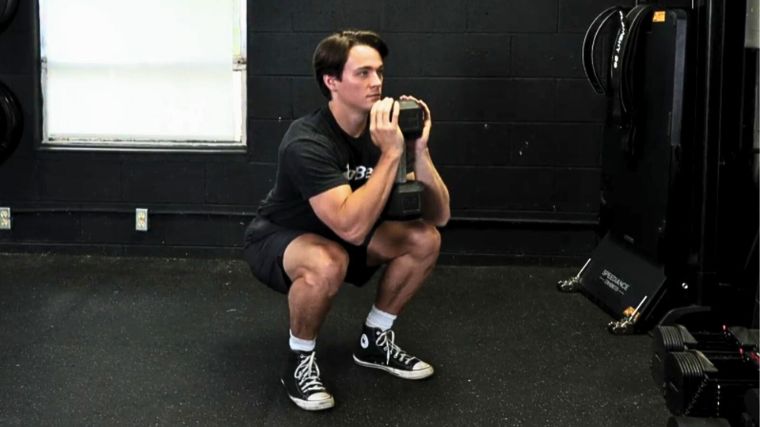
Recent Updates: On May 5, 2024, BarBend Senior Writer Jake Dickson reviewed this article for quality and updated its content to make the prescriptions more accessible. You can find additional information on modifications, as well as set-rep prescriptions and a breakdown of what muscles you work when you do goblet squats below.
How To Do the Goblet Squat
You can do goblet squats with dumbbells or kettlebells, but we recommend using a dumbbell since they’re generally more accessible. Regardless of what type of weight you’re using, you can learn how to goblet squat properly in three simple steps:
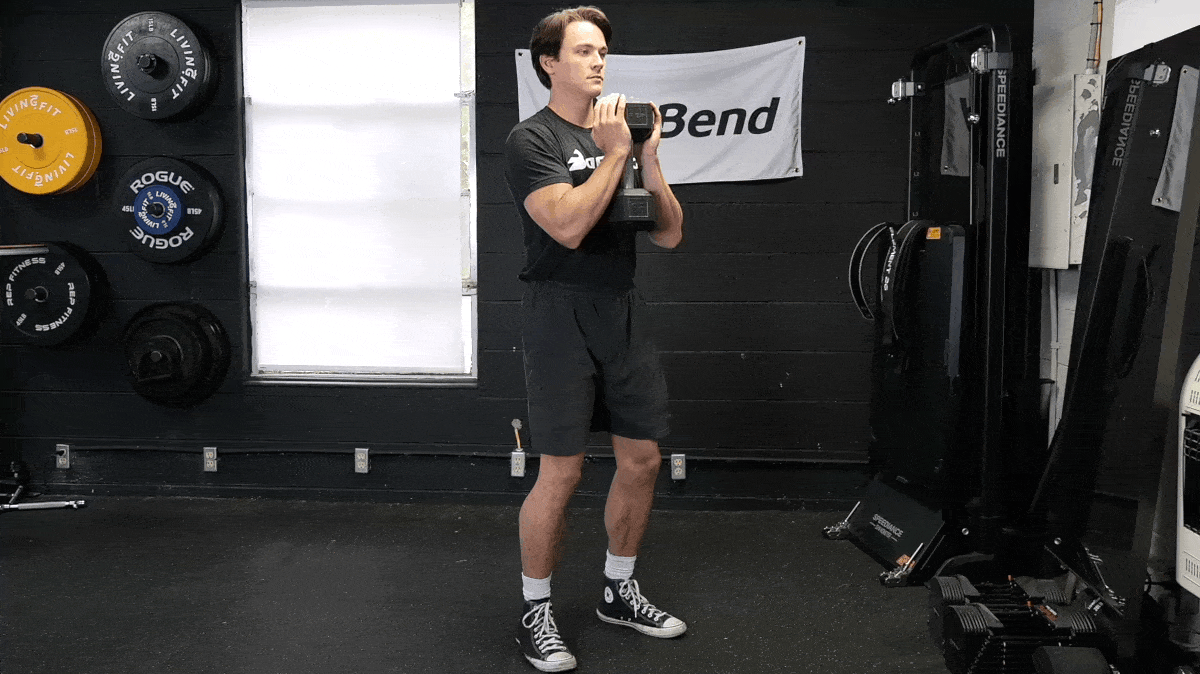
[Read More: The Benefits of the Goblet Squat to Bring Glory to Your Leg Days]
- Step 1 — Set your feet shoulder-width apart. Then, grab a dumbbell or kettlebell and hold the weight directly under your chin with your elbows tucked in. Brace your core, tense your back, and ensure that you feel stable. Think about pulling your ribs down into the body and making sure your abs are engaged.
- Step 2 — Grip the floor with your feet. Keep your feet firmly planted, and then twist them outward until you feel your quads, hamstrings, and glutes light up. Then drop down, keeping your torso upright until the bottom of your thighs are at least parallel to the floor.
- Step 3 — Reverse the motion by pushing straight down into the floor with your legs and ascending until you return to the starting position.
Sets and Reps
- For Beginners: 3 x 10
- To Build Strength: 5 x 5
- Gain Endurance: 4 x 15
Modifications
- Emphasize Your Quads: Wear weightlifting shoes or stand with your heels on small change plates so you can
- For Muscle Hypertrophy: Try one-and-a-half reps, doing the bottom portion of the range of motion twice before standing up all the way.
- Train Power: Try jumping goblet squats; as you stand up, push into the floor and do a slight vertical hop.
Goblet Squat Variations
Below are a few goblet squat variations that you can play with if the standard movement isn’t right for you.
- Box Goblet Squat: You can do goblet squats to a plyo box or chair as a way of limiting your depth and helping you get familiar with the motion of squatting with weights.
- Elevated Goblet Squat: Elevating your heels by wearing weightlifting shoes or standing on a pair of small weight plates makes it easier to keep your torso upright and engage your quadriceps.
- Kettlebell Goblet Squat: Using a kettlebell instead of a dumbbell won’t change the mechanics of the exercise at all, but clasping the bottom of the bell may be more comfortable on your wrists than holding the underside of a dumbbell.
- Sumo Goblet Squat: Taking a sumo stance will allow you to train muscles like your hip adductors and glute medius by stressing your hips more than your knees.
Goblet Squat Alternatives
When you’re ready to change things up and progress the goblet squat to something a bit more complex, give one of these a try.
Front Squat
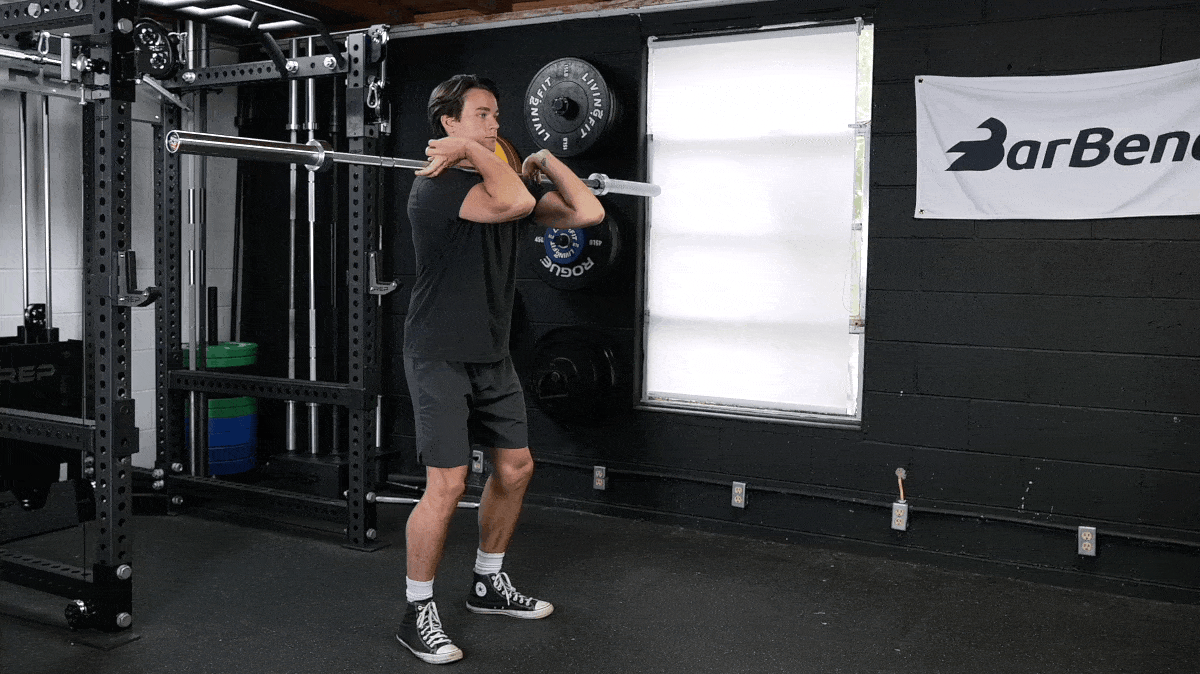
[Read More: Front Squat vs. Goblet Squat — How To Choose]
- Stand upright in your normal squat stance while holding a barbell in the front rack position.
- From here, take a breath in. Point your elbows mostly forward, and then slowly sit down into a deep squat.
- Maintain an upright torso so your elbows never come into contact with your legs. Squat as low as you can, then push with your legs to stand back up to the starting position.
Zercher Squat
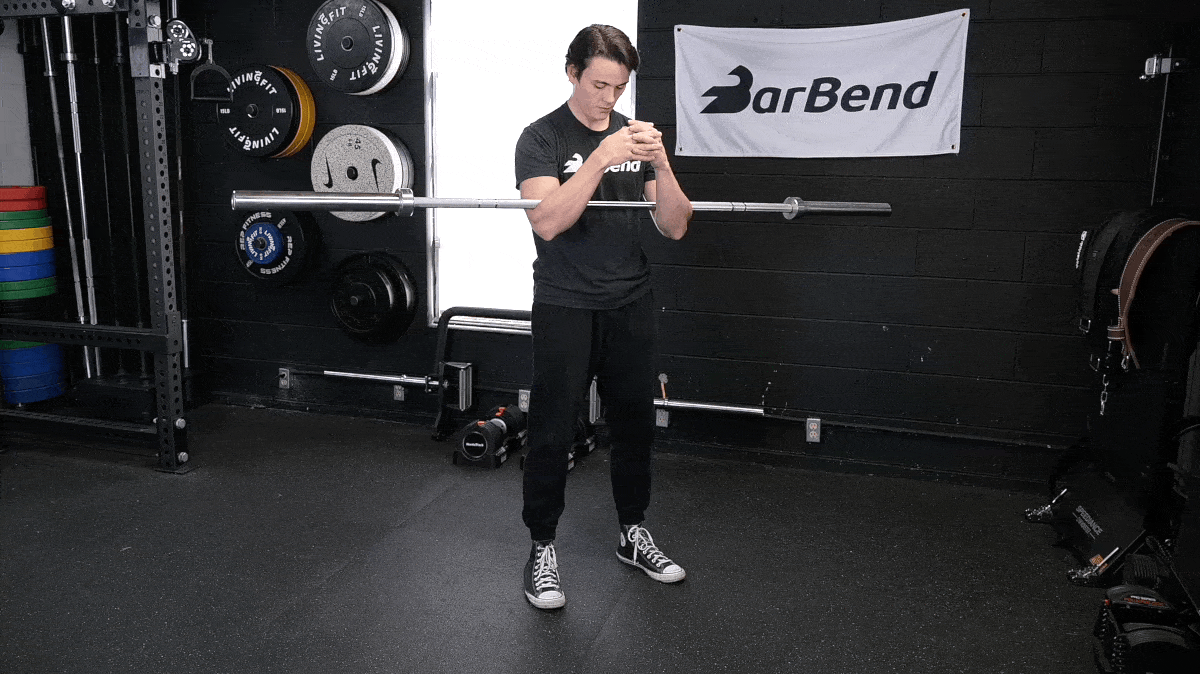
[Read More: Zercher Squat vs Goblet Squat: Which One Is Right for You?]
- Assume your usual squat stance. Secure a barbell in the crooks of your elbows by bending your arms and clasping your hands together in front of your chest.
- From here, brace your core and sink down into a squat.
- Take care to avoid letting your elbows make contact with your thighs. Squat as low as you can, then stand back up.
Goblet Squat Muscles Worked
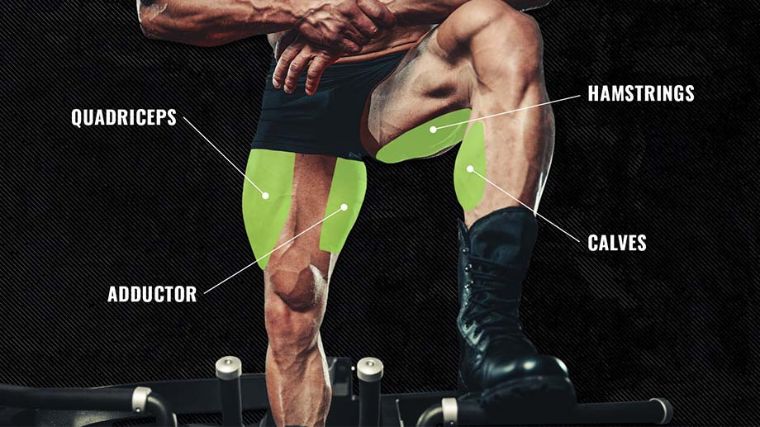
[Read More: The Beginner-Friendly Squat Variations]
Here’s a brief rundown of the various muscles you use when you perform dumbbell goblet squats, kettlebell goblet squats, or any other variation you enjoy:
- Quadriceps: Your quadriceps lie on the front of your thighs and primarily function to flex and extend the knee joint. This is the primary muscle you work when you do goblet squats.
- Glutes: Most squat variations engage your glutes. The glutes perform hip extension, so the deeper you sit into the bottom of the goblet squat, the more you’ll stretch and train your glutes.
- Core: An upright core is a hallmark feature of all goblet squats, and that responsibility falls on your abdominal muscles to contract isometrically and keep your trunk rigid.
- Upper Back: Holding a weight in the goblet position will challenge your upper back muscles as well, as they strain to stabilize your thoracic and cervical spine, resisting the weight as it attempts to round you over.
Goblet Squat Benefits
The goblet squat is one of the most utilitarian movements. Here are five reasons to add it to your training toolbox.
A Valid Teaching Tool
The anterior loading position of the goblet squat makes it a great beginner-friendly option for learning (or teaching) how to squat. Even rank beginners should find the fundamental movement pattern quite natural. Simply put, the goblet squat is a great instructive tool for learning how to move properly with weights.
Postural Strength in the Squat
By loading in the goblet position, you have absolutely no choice other than to maintain a rigid and extended thoracic spine. If you can’t, the weight will simply fall out of your hands. This ensures that you train your posture effectively with the goblet squat.
Enhanced Core Strength
Squats are a great way to increase core strength, and front-loaded variations are even better. Like the front squat, the goblet squat is a challenging variation to teach lifters (beginners especially) how to brace, not overextended through the spine in the descent, and stay balanced and controlled throughout the squatting movement. Challenging in a good way, that is.
They’re Accessible
Goblet squats are perfect for home gym owners who don’t own a barbell. Whether you have kettlebells, dumbbells, or even heavy rocks at your disposal, goblet squats can be your go-to squatting movement. That said, if squatting a lot of weight is your chief goal, then you’ll want to back squat. It allows you to lift the most weight possible. Goblet squats can still serve you as a great accessory movement, though.
They’re More Back-Friendly
Since you aren’t working with the barbell, the goblet squat intrinsically limits the amount of external load you use. While this doesn’t directly correlate to being “better” for your back than a barbell squat, it does serve as an easy means of ensuring you don’t put your spine through too much stress.
[Read More: The Best Weight Plates: Rubber, Steel, Urethane, and More]
If you’re working through or around an injury, or simply have low tolerance to high amounts of weight, the goblet squat is a prime choice.
Common Goblet Squat Mistakes
The goblet squat is pretty hard to screw up, but there are still a few specific things to keep in mind in order to have solid technique and make use of the movement.

[Read More: The Best Adjustable Dumbbells for Your Home Gym]
Tilting Forward
The main hallmark of the goblet squat is that the load you’re using is placed in front of your body, instead of behind your head like in a back squat. This anterior load helps you maintain a more upright and vertical torso when you squat. As such, you should avoid purposely tilting your torso forward or shooting your hips backward. This is counterintuitive to the purpose of the goblet squat.
Resting the Weight On Your Body
You’re meant to suspend the implement you’re using in space with your arms, not lean it up against your chest or collarbones. By holding the weight aloft, you challenge your upper back and core to a greater degree, turning the goblet squat into an effective full-body stimulus.
Half-Squatting
When you squat, it’s important to respect your mobility. That said, out of all the squat variations under the sun, the goblet squat is among the most depth-friendly styles you can perform. The placement of the weight and moderate load should make it quite easy to sit your hips into a deep squat, even if you’re new to squatting in general.
Your Goblet Runneth Over
No movement does everything, but the goblet squat sure comes close. For how simple and easy to perform the exercise is, the goblet squat sure brings a lot to the table for your performance and mobility.
“Beginner” movements are often used by intermediate and advanced athletes throughout their careers, and the goblet squat is no exception. Taking things back to basics can help you remember how to move properly, encourage you to find your mind-muscle connection and, most importantly, simply help you pack on some new leg muscle.
The goblet squat accomplishes all this and more. Give them a try and you’ll be pouring one out for your subpar leg gains.
Frequently Asked Questions
What is the difference between the goblet squat and the sumo squat?
The sumo squat is done with a wider stance. You can do sumo squats using any weight and any form you want (goblet or front squat or back squat). The goblet squat is done with a dumbbell or kettlebell in the front rack position, with a standard squat stance.
How deep should I squat?
Like most squats, your goal and abilities will dictate the depth to which you squat. If you can assume a full range of motion squat (one that the back of the hamstrings smush against the calves), do goblet squats to full depth. If you are looking to isolate a specific range of motion or sticking point, you can restrict the range of motion to that particular range. For best results, aim to squat as low as you can without pain, with control and a neutral spine.
Can advanced lifters build muscle with goblet squats?
Yes. While advanced lifters may find that they need to use heavier loads to elicit muscle growth, goblet squats are a great leg-building exercise for most individuals. However, when done for higher reps, upper back strength, core stability, arm strength, and endurance can become limiting factors.